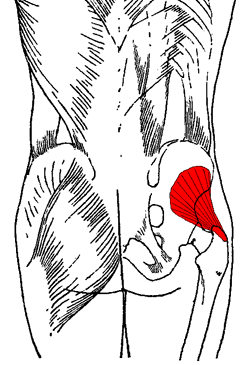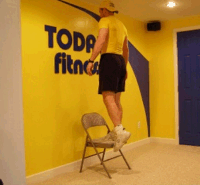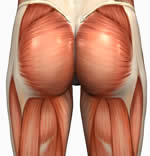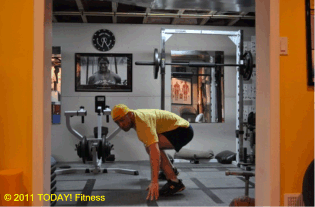|
Happy New
Rear! |
|
Most people don't have buns of
steel, sad to say, and search far and wide for the best butt
exercises that will firm up the old rear end. Do me a favor:
stand up and take a look at your butt. Study it closely and
tell me...are you happy with it? You probably said no. Like
the rest of us, you probably think your butt is too small,
too big, too saggy, or too flabby. If you're nodding your
head, there is something you can do. The right cardio
exercise and weight training activities (think squats and
deadlifts) can make a difference.
Your butt is composed of 3 main
muscles:
|
Gluteus maximus |
Gluteus medius |
Gluteus
minimus |
|
 |
 |
 |
The gluteus maximus is the largest and most
superficial of the three gluteal muscles. It makes up a large portion of the
shape and appearance of the
buttocks. This
is where most of your focus will be. The other
two (the gluteus medius and minimus) are important too,
though--they lie under the gluteus maximus and hold your
pelvis upright every time you take a step. Not only that,
your butt muscles are in charge of all the movements of your
hips, including:
- extension (moving the
thigh backward)
- external rotation (turning
the thigh or pelvis outward)
- transverse abduction
(moving the thigh outward with hip bent)
- adduction (moving the
thigh inward with hip straight).
When it comes
to athletic performance, your butt is one of the most
important muscles in your arsenal. The gluteus maximus
is considered to be the engine that propels you forward when
you are sprinting, jumping, skating or most other actions
that involve lower body power. With any strength and
conditioning program for athletic performance, you will find
a strong focus on exercises such as squats and deadlifts
that target the glutes.
Targeting your Gluteus
Maximus
If you have a little butt-flab, you have to lose body fat to
get rid of it. The quickest way to do that is with cardio
exercise, weight training and a healthy diet. Cardio is a
must if you're trying to drop fat, so choose activities that
allow you to burn the most amount of calories in the least
amount of time, like these:
-
Interval training - bouts of high intensity cardio mixed
with low intensity rest periods
- Doing something completely
different than usual (if you're a runner, try swimming...a walker, try cycling)
- Increase your intensity
-Going faster and harder burns more calories, but watch
your
heart rate
-
Lift heavy weights regularly - forget the low weights
and high reps. Challenge your muscles!
- Target your butt by trying
these activities: hiking, stair-climbing, cycling, and
step aerobics
I featured this exercise in
my newsletter a few years ago, but since we're on the topic,
this single leg chair squat (step-up) is a perfect body
weight exercise for blasting your butt!

Plenty of folks out there
still think that stair-climbing or cycling will enlarge
their rears. But, like many myths out there, it simply isn't
true. Your body has different muscle fibers: slow-twitch and
fast-twitch. Fast-twitch muscle fibers (think of
bodybuilders) are made to lift heavy weights and grow
larger. The slow-twitch fibers (think marathon runners) are
made for endurance and can't get very big. Remember that
when you do aerobic exercise, you're relying on your
slow-twitch muscles so they will NOT get bigger from cardio. Plus, building muscle
requires progressive resistance--constantly giving your
muscles more weight than they can handle so they grow
stronger. While there is some resistance in many cardio
machines, there isn't enough there for that progressive
resistance.
The End ; )

ref: myfit.ca, exercise.about.com
|
|
Stable Surface
is Best |
For a while there,
exercising on unstable surfaces was the trendy thing
to do. BOSU balls, wobble boards, balance
beams, and the like could be found in every gym and
training studio and it seemed like every exercise
being represented in the magazines had some type of
instability focus to it. Now I'm not saying
that all instability exercises are bad for you, but
recent research is stating that straight up strength
training is best accomplished without the additional
focus on instability.
Exercising on stable
ground builds core stability and increases lower and
upper-body strength. No study has found that
exercising on unstable surfaces improves athletic
performance or builds significant strength in major
muscle groups better than training on firm ground.
An Appalachian State
University study found that stable squatting was
superior to unstable squatting for overloading the
lower-body muscles. The best total-body
strength exercises include kettlebell swings and
snatches, squats, deadlifts, standing overhead
presses, and plyometrics (jump training).
These exercises use heavier loads, shorter tension
times, and higher speeds than exercises on unstable
surfaces. Ground-based exercises have the same
force, velocity, and core-stabilizing elements
required in most sports and movement skills.
The take-home message is to stay grounded for strong
muscles!
ref:
International Journal Sports Physiology Performance
|
|
Nuts Promote
Weight Loss |
|
Eating nuts to lose weight
doesn't make any sense. They are calorie dense and
high in fat. Only one ounce of mixed nuts contains 174
calories and 15.9 grams of fat. Why do nutritionists
recommend nuts as part of a healthy diet? Richard
Mattes and Mark Dreher from Purdue University, in a review
of literature, concluded that nuts contain many healthy
nutrients and antioxidants that prevent degenerative
diseases such as coronary artery disease and cancer.
Large population studies found a link between high nut
consumption and reduced body fat. Nuts prevent hunger
and are poorly absorbed in the gut. They also increase
the energy cost of digestion and improve dietary compliance
during weight loss. Nuts are valuable for weight loss,
as long as you don't eat too many of them.
ref: Asia Pacific Journal
Clinical Nutrition |
|

|
|
|
Bodyweight Exercise of the Month! |
|
180 Jump
Squats

Summary:
This exercise is simple, yet very
effective. I came across it doing the P90X Plyometric X
DVD and liked it so much that I made some of my wrestlers hit
it for 30 second and 1 minute bursts. Depending on the
duration of your intervals, it will really challenge your
cardio while also giving you a great burn in your thighs and
glutes.
Target: legs and butt
(quadriceps, hamstrings, gluteus maximus)
Count:
2 count
Description: With
your feet at least shoulder width apart, assume a squatted
position facing one side or the other, with your forward hand
on the ground and looking straight ahead. Jump in the
air and turn your body 180 degrees so that you are in the same
position facing the opposite side. Repeat this explosive
motion for repetitions or time, trying to limit your ground
contact time and keeping a brisk pace.
|
|
Potassium |
|
If you have
participated in any kind of race, marathon, bike ride, or
pretty much any type of endurance event... you have probably
seen and consumed your share of bananas! That's
because they are a low-fat, high-potassium fruit... and they
even come prewrapped! Bananas are excellent for
replacing potassium lost in sweat.
Potassium, sodium and
chloride comprise the electrolyte family of minerals. Called
electrolytes because they conduct electricity when dissolved
in water, these minerals work together closely. About 95% of
the potassium in the body is stored within cells, while
sodium and chloride are predominantly located outside the
cell.
Potassium assists in muscle contraction
and in maintaining the electrolyte balance in body
cells. Potassium is especially
important in regulating the activity of muscles and nerves.
The frequency and degree to which our muscles contract, and
the degree to which our nerves become excitable, both depend
heavily on the presence of potassium in the right amount.
Potassium is important in releasing energy from protein, fat, and
carbohydrates during metabolism of other
foods we eat. Potassium
also protects against high blood pressure.
When you sweat,
you lose not only water but also minerals (electrolytes)
such as potassium and sodium that help your body function
normally. A pound (16 oz) of sweat contains about 80
to 100 milligrams of potassium and about 400-700 milligrams
of sodium. Assuming that the harder you exercise, the
hungrier you'll get and the more you'll eat, you'll consume
more than enough electrolytes from standard post exercise
foods. You won't need salt tablets or special
potassium supplements. For example, a marathoner who
guzzles a liter of orange juice after completing the event
replaces three times the potassium they might have lost and
munching on a bag of pretzels will more than replace any
lost sodium.
Potassium may play a role in the prevention and/or
treatment of the following health conditions:
-
Atherosclerosis
- Cataracts
- Dehydration
-
Diabetes
- Hepatitis
- High blood pressure
- Inflammatory bowel
disease
- Osteoporosis
- Potassium depletion due
to excessive fluid loss from diarrhea, vomiting, or
sweating
The kidneys regulate the
level of potassium in the body. Potassium deficiency is
not common but may result from excessive losses due to
severe diarrhea, poor diabetic control, low-calorie diets
(less than 800 calories per day), chronic alcoholism, hard
exercise or overuse of muscles, or some diuretics and laxatives. The symptoms of potassium
deficiency include muscle weakness, confusion,
irritability, fatigue, and heart disturbances. Athletes
with low potassium stores may tire more easily during
exercise, as potassium deficiency causes a decrease in
glycogen (the fuel used by exercising muscles) storage.
Electrolyte
imbalance, such as lack of potassium, may play a role in
muscle cramps. But a potassium deficiency is unlikely
to occur as a result of sweat losses because the body
contains much more potassium than even a marathoner might
lose during a hot, sweaty race. Nevertheless, you can
rule out this issue by eating potassium-rich foods on a
daily basis. Since potassium functions
in close cooperation with sodium, imbalanced intake of
salt (sodium chloride) can also increase a person's need
for potassium. Higher amounts of potassium are also needed
by persons with high blood pressure.
Athletes also may need more
potassium to replace that lost from muscle during exercise
and the smaller amount lost in sweat. Low potassium can
cause muscle cramping and cardiovascular irregularities.
Eating foods high in potassium can prevent these symptoms.
One cup of orange juice, a banana or a potato is
sufficient to replace the potassium lost during one to two
hours of hard exercise. Sport drinks are poor sources of
potassium.
In addition, a diet that is
high in sodium and low in potassium can negatively impact
potassium status. While the typical American diet, which
is high in sodium-containing processed foods and low in
fruits and vegetables, contains about two times more
sodium than potassium, many health experts recommend
taking in at least five times more potassium than sodium.
The recommended daily potassium intake is 4.7 grams (4,700
milligrams) a day. This is
easy to do if you are a salad lover. Athletes involved in
prolonged, hard exercise may require more potassium a day.
Besides bananas,
other foods rich in potassium include: potatoes,
yogurt, orange juice, pineapple juice, raisins, spinach, crimini
mushrooms, broccoli, winter squash, eggplant, cantaloupe,
cucumber, bell pepper, strawberries, cauliflower and
cabbage, and various
other fruits and vegatables. It also can
be obtained from tuna and halibut. You can find a
list of the daily recommended requirements by going to the
US Food and Drug Administration website.
ref:
Sports Nutrition Guidebook, eHow, whfoods.com
|
|
It's Go Time!
|
|
Ok... raise your right hand and
repeat after me... I (state your name) hereby resolve to...
and then fill in some time of concrete and specific resolution
for yourself for 2011! Ok... how many of you actually
said "state your name"? Get serious people!... Everyone
knows how important goals are, but most of us don't take the
time to formally commit to them! By formally commit to
them I mean right them down and look at them regularly (daily,
weekly, monthly) and by specific I mean REALLY think about it
and be serious about what you want to accomplish
realistically. Goals such as "I will lose weight" or "I
will start working out" are garbage. Think more like "I
will reduce my daily caloric intake by 500 calories per day by
cutting out the soda, chips, etc..." or "I will begin working
out in January by doing 30 minutes of interval cardio 3 days
per week and total body resistance training for 45 minutes 2
days per week." These specific goals/resolutions help
your commitment and motivation by really making you consider
what you are willing to do and then start planning your
schedule and routine around getting it done. Hey, we're
all busy people... make an appointment with yourself if that
helps... whatever works... just get it done and take it upon
yourself to make this a year of CHANGE! For
prior issues of this eNewsletter, to subscribe, or
unsubscribe, please visit the following
link -->
todayfitness.net/news.
Exceed Your
Potential!
Pete
Mazzeo, CPT
pmazzeo@todayfitness.net
"You
were born to win, but to be a winner, you must plan to win,
prepare to win, and expect to win."
- Zig Ziglar
youtube of the month -->
Shawn T Interview
Very informative interview with Shawn T, creator of
INSANITY and Hip Hop Abs.
|
|